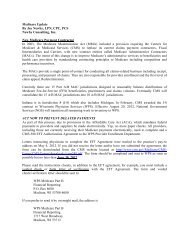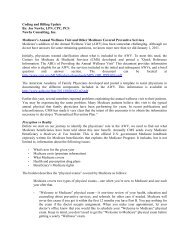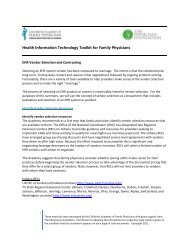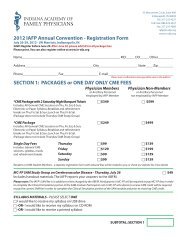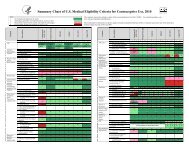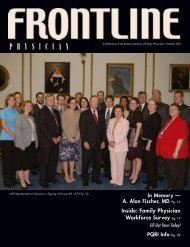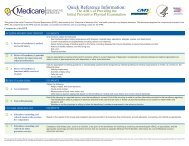pqri measure coding and reporting principles - Indiana Academy of ...
pqri measure coding and reporting principles - Indiana Academy of ...
pqri measure coding and reporting principles - Indiana Academy of ...
You also want an ePaper? Increase the reach of your titles
YUMPU automatically turns print PDFs into web optimized ePapers that Google loves.
HOME SERVICES – CPT CODES 99341-99350<br />
Medicare Claims Processing Manual Chapter 12 §30.6.14.1 (Codes 99341-99350) (Rev. 1, 10-01-03) B3-<br />
15515, B3-15066<br />
A. Requirement for Physician Presence<br />
Home services codes 99341-99350 are paid when they are billed to report evaluation <strong>and</strong> management<br />
services provided in a private residence. A home visit cannot be billed by a physician unless the physician<br />
was actually present in the beneficiary’s home.<br />
B. Homebound Status<br />
Under the home health benefit, the beneficiary must be confined to the home for services to be covered.<br />
For home services provided by a physician using these codes, the beneficiary does not need to be<br />
confined to the home. The medical record must document the medical necessity <strong>of</strong> the home visit made<br />
in lieu <strong>of</strong> an <strong>of</strong>fice or outpatient visit. [Emphasis Added]<br />
SCREENING PAP SMEARS AND SCREENING PELVIC EXAMINATION<br />
(INCLUDING CLINICAL BREAST EXAM)<br />
Medicare Benefit Policy Manual Chapter 15 §280.4 (Rev. 1, 10-01-03) A3-3628.1, B3-4603.1<br />
Effective, July 1, 2001, the Consolidated Appropriations Act <strong>of</strong> 2001 (P.L. 106-554) modifies §1861(nn)<br />
to provide Medicare coverage for biennial screening Pap smears or more frequent coverage for women:<br />
1. At high-risk for cervical or vaginal cancer<br />
2. Of childbearing age who have had a Pap smear during any <strong>of</strong> the preceding three years indicating<br />
the presence <strong>of</strong> cervical or vaginal cancer or other abnormality<br />
Cervical Cancer High-Risk Factors<br />
1. Early onset <strong>of</strong> sexual activity (under 16 years <strong>of</strong> age)<br />
2. Multiple sexual partners (five (5) or more in a lifetime)<br />
3. History <strong>of</strong> a sexually transmitted disease (including HIV infection)<br />
4. Fewer than three negative or any Pap smears within the previous seven years<br />
Vaginal Cancer High Risk Factors<br />
1. DES (diethylstilbestrol) - exposed daughters <strong>of</strong> women who took DES during pregnancy<br />
The term “woman <strong>of</strong> childbearing age” means a woman who is premenopausal, <strong>and</strong> has been determined<br />
by a physician, or qualified practitioner, to be <strong>of</strong> childbearing age, based on her medical history or other<br />
findings. Payment is not made for a screening Pap smear for women at high-risk or who qualify for<br />
coverage under the childbearing provision more frequently than once every 11 months after the month<br />
that the last screening Pap smear covered by Medicare was performed.<br />
For Claims with Dates <strong>of</strong> Service on or After July 1, 2001<br />
When the beneficiary does not qualify for a more frequently performed screening Pap smear as noted in<br />
items 1 <strong>and</strong> 2 above, contractors pay for the screening Pap smear only after at least 23 months have<br />
passed following the month during which the beneficiary received her last covered screening Pap smear.<br />
All other coverage <strong>and</strong> payment requirements remain the same.<br />
5-43<br />
*All CPT Codes, Descriptions, <strong>and</strong> Two-Digit Modifiers<br />
Only Are Copyright 2006 American Medical Association. GEN 2007 REV 07-01<br />
Copyright 2007 Newby Consulting, Inc.



